All the Way to the FBI
J. Edgar Hoover did not have to wait for Clint Eastwood and Leonardo DiCaprio to get his big break in the movies. J. Edgar, the current biopic chronicling the life, times, and repressed sex life of the FBI overlord, is only the latest in a long chain of cinematic links handcuffing Hollywood to the man behind the most famous acronym in American law enforcement. Indeed, the trajectory of Hoover's box office career is a fair reflection of his changing profile in the cultural lineup—from top-billed star to Public Enemy No. 1.
Appropriately, Hoover's first entry into the mythos of the movies came in a real-life scenario that might have sprung from the imagination of a hack screenwriter. For 14 months in 1933-1934, as Hoover's nascent Division of Investigation of the Department of Justice fought for turf with the other alphabet agencies created under FDR's New Deal, the dashing bank robber John Dillinger was making a fool of lawmen throughout the Midwest. Worse yet from a public policy perspective, his crime spree and daring escapes delighted many Depression-battered Americans who figured anyone sticking up the financial system was a force for justice. After spectacularly bungling a stakeout in Little Bohemia, Wisconsin (Dillinger gang member Baby Face Nelson killed an FBI agent and wounded two lawmen; FBI agents killed an innocent civilian in the crossfire), Hoover needed to carve a notch on his belt, fast. On the humid evening of July 22, 1934, in the first of the agency's great public relations coups, Dillinger was gunned down by special agent Melvin Purvis in front of the Biograph Theater in Chicago after watching the MGM gangster film Manhattan Melodrama (1934). The newsreels lingered over the morgue shot of the deceased desperado and the commentators barked out a new twist on the crime-does-not-pay angle: "The federal government always gets its man!"
While Hoover was getting gangsters whacked, he also helped shoot down their motion picture kinsmen. Virtually concurrent with Dillinger's sidewalk killing, Hollywood began enforcing the Production Code, a stern set of commandments mandating morality onscreen, a move that promptly silenced the insurrectionist glee of the wisecracking gangster films of the early 1930s. The new order in town was heralded by Warner Bros.' "G" Men (1935), the title taken from a term introduced two years earlier when Machine Gun Kelly, cornered by Hoover's men, pleaded, "Don't shoot, `G' men!" None other than James Cagney, the actor who had made his bones as a gun-crazy, grapefruit-wielding street tough in The Public Enemy (1931), defected to the Feds in this bellwether genuflection to Hoover hegemony. "The government men are the heroes," wrote Code chieftain Joseph I. Breen. "It made you feel proud to be an American."
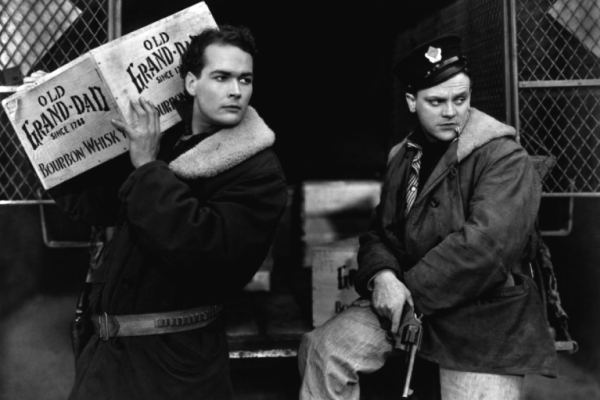
Edward Woods and James Cagney in The Public Enemy
By the mid-1930s, the shadow of the newly christened Federal Bureau of Investigation loomed over all platforms of American entertainment, not to say the back of cereal boxes. Inspired by radio shows and motion picture serials, battalions of boys enlisted as "Junior G-Men" and kept alert for criminal activity around the neighborhood. Newsreel appearances from the media savvy Hoover trumpeted each new FBI catch, scratching off mug shots labeled Public Enemy No. 1 and (after 1950) enumerated on the FBI's Ten Most Wanted list. While organized crime extended its tentacles largely unencumbered by FBI interference, the federalization of law enforcement proceeded apace, siphoning authority away from the local cop on the beat to the gray men in the citadel in Washington, D.C. Local police captains resented the credit-hogging publicity hounds ("Famous but incompetent," they groused), but the national media doted on Hoover and the men cast in his image.
With the name brand gangsters of the era either dead or behind bars, the FBI turned to subversive threats to the body politic—first Nazis, then communists. Hollywood followed the Hoover script as if taking dictation. In Confessions of a Nazi Spy (1939), an FBI agent (Edward G. Robinson, another former gangster type) stumbles upon a Nazi spy ring operating in New York. Based on an authentic case, the gutsy thriller from Warner Bros. marked the first time the word "Nazi" had appeared on the marquee of a major Hollywood feature film. In line with Hoover's agenda, it also called for an elaborate internal security network to combat the threat from fifth columnists, a policy soon abetted by wartime exigencies. Watching, wiretapping, and infiltrating, the civilian soldiers of the FBI were the nation's first line of defense against the enemy within.
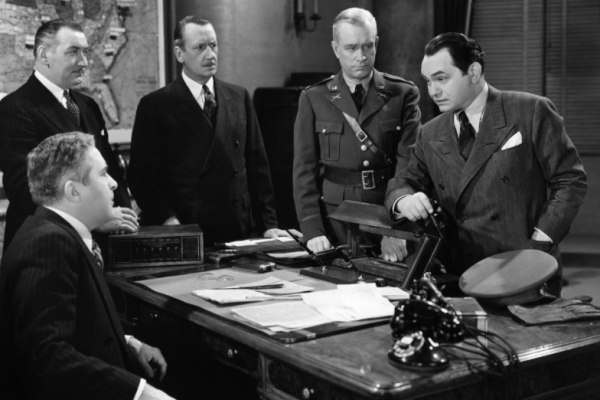
Edward G. Robinson (right) in Confessions of a Nazi Spy
The apparatus forged during World War II was not decommissioned in peacetime. By the early years of the Cold War, the FBI had become as well known for counter-espionage as collaring criminals. In I Was a Communist for the FBI (1951) and the popular television series I Led 3 Lives (1953-1956), undercover agents risked contamination from Moscow to expose the masters of deceit in our midst. Esteemed universally as the incorruptible sentinel who kept the nation safe from spies and crooks alike, Hoover had by then firmly established himself as the most powerful unelected government official in American history. President Truman might be assailed by the Republicans, President Eisenhower might be mocked by the Democrats, but no leader of either party dared to attack J. Edgar Hoover. In 1954, during the Army-McCarthy hearings, both sides agreed that "John Edgar Hoover and his men" were the watchdogs par excellence, prompting an exasperated Joseph M. Welch, attorney for the Army, to ask Roy Cohn, chief counsel for the McCarthy committee, "Then what's all the excitement about if J. Edgar Hoover is on the job chasing . . . communists?"
The high-water mark for FBI hagiography was The FBI Story (1959), an institutional biopic from Warner Bros., a studio still doing penance for its early gangster films. Jimmy Stewart, the embodiment of common man decency, stars as a composite FBI everyman tracking the bureau's history from Prohibition through the Cold War, defeating in turn each new threat to the domestic tranquility and national security: bootleggers, gangsters, Klansmen, Nazis, and communists. Made with FBI cooperation, it shows a glimpse of Hoover himself in a brief opening vignette, though the rest of the story treats him pretty much the way God appeared in Cecil B. DeMille movies: a divine presence hovering just offscreen, too sacred to be played by a mortal actor.
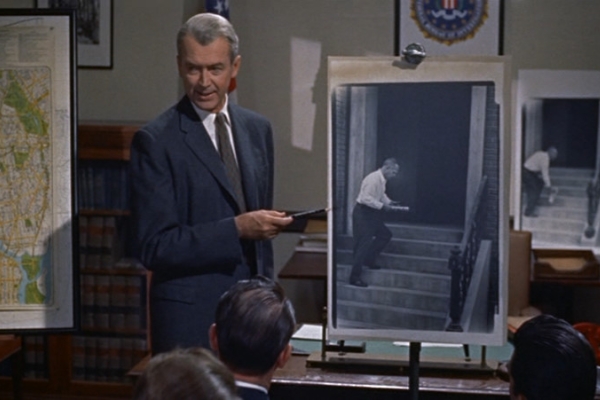
James Stewart in The FBI Story
The FBI Story etched in stone the Hoover vision of the modern crime fighter. No trigger-happy sheriff, the lawman was a collector of data more at home with paperwork than marksmanship, a calm professional who used microscopes and state of the art technology (including the new IBM card sorting machines) to run the perp to ground. The camera pans row after row of desks and file cabinets at FBI headquarters, a bustling nerve center of ballistics, fingerprints, and surveillance reports, spinning out a web none can escape.
In the 1960s, because of the 1960s, the blue-chip stock of J. Edgar Hoover finally took a downturn. The tension with the Kennedy brothers, the tales of extra-legal activity, and the sense that the long-serving FBI head was getting a tad too eccentric and long in the tooth made even his ideological allies wary. By 1972, President Nixon was looking for a reason to send him out to pasture. The risky political decision was avoided when Hoover—after 55 years at the Department of Justice—died in harness.
With Hoover's death, American popular culture, so long in thrall to the FBI demigod, took posthumous revenge. Larry Cohen's The Private Files of J. Edgar Hoover (1977) struck the first body blow, with a boozy Broderick Crawford playing Hoover in what the shocked reviewer in Variety called a "tawdry exposé," depicting the former American hero as a "vindictive puritanical paranoid" who was also "a mama's boy and a homosexual." Subsequent filmmakers were no kinder, though more politically minded. In Spike Lee's Malcolm X (1992) and Oliver Stone's Nixon (1995), Hoover and the men of the agency who had once embodied all that was good about protective governmental oversight had morphed into sinister, all-knowing Big Brothers, tapping phones, pulling strings, and orchestrating murders.
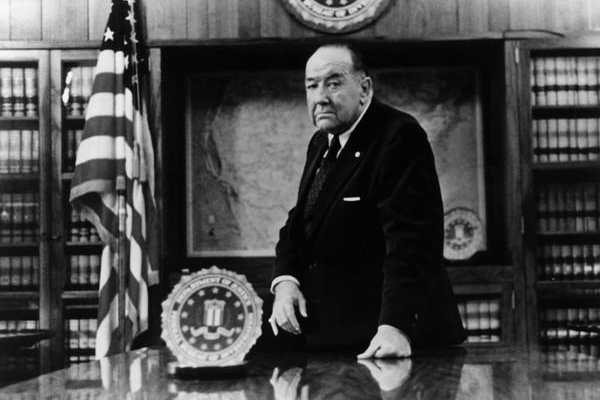
Broderick Crawford in The Private Files of J. Edgar Hoover
More sensational than the revelation that the chief G-man was a gay man, perhaps so deeply closeted he may not have known it himself, was the claim that his workplace dress code of gray suits and brown shoes was not his preferred garb around the house. "The Secret File on J. Edgar Hoover," a 1993 episode of the PBS series Frontline, in tandem with a book by British journalist Anthony Summers, Official and Confidential: The Secret Life of J. Edgar Hoover, bluntly asserted not only that Hoover held hands with Clyde Tolson, his FBI BFF, but that at home he donned wig, black dress, stockings, and high heels. The image of the button-down, bulldog-faced Hoover dolled up in full-on drag was a visual so irresistible that it erased a half-century of FBI public relations work. In America, Freud beats out Orwell every time.
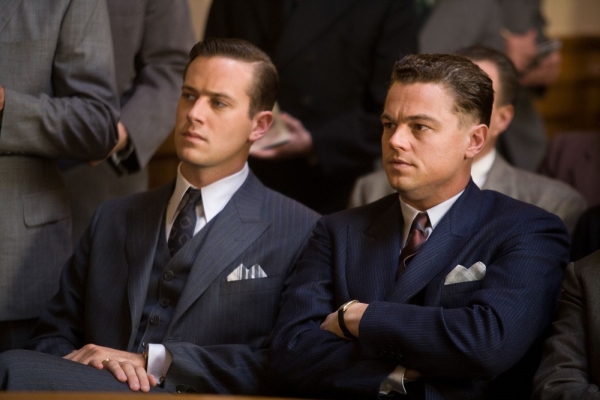
Armie Hammer and Leonardo DiCaprio in J. Edgar
Yet if Hoover himself has become a punch line or a Central Casting villain for Hollywood, the agency he created remains a durable source of detective heroes and crime scene investigators, still the gold standard for professionalism and integrity. Even at the height of Hollywood's Hoover hatred, two FBI agents were celebrated in Mississippi Burning (1988) as crusaders for civil rights when, at best, the FBI was a disinterested observer. Locked in a codependent relationship, American entertainment continues to shoot G-men in a largely favorable light: without Hoover's enduring legacies to law enforcement—forensic science and the modern crime lab—network television would be paralyzed. No wonder, in The Silence of the Lambs (1991) when the serial killer Hannibal Lecter tries to psych out FBI trainee Clarice Starling by calling her a descendant of "poor white trash," the irony in his voice is tinged with a trace of awe. She has, after all, made it "all the way to the Ef . . . Be . . . Eye." ![]()
LATEST ARTICLES
-20140814-173707-thumb3.jpg)
Fighting Words
by Imogen Sara Smith
posted August 12, 2014

Fighting Words, Part 2
by Imogen Sara Smith
posted August 20, 2014

On the Margins: The Fil…
by Andrew Chan
posted August 12, 2014

Robin Williams: A Sense…
by David Schwartz
posted August 12, 2014
 All the Way to the FBI
All the Way to the FBI
KEYWORDS
biopic | J. Edgar Hoover | Hollywood | sexuality | Cold War | The Great Depression | gangster film | FBITHE AUTHOR
Thomas Doherty is professor of American Studies at Brandeis University and the author of Hollywood's Censor: Joseph I. Breen and the Production Code Administration (Columbia University Press, 2007).
More articles by Thomas Doherty
